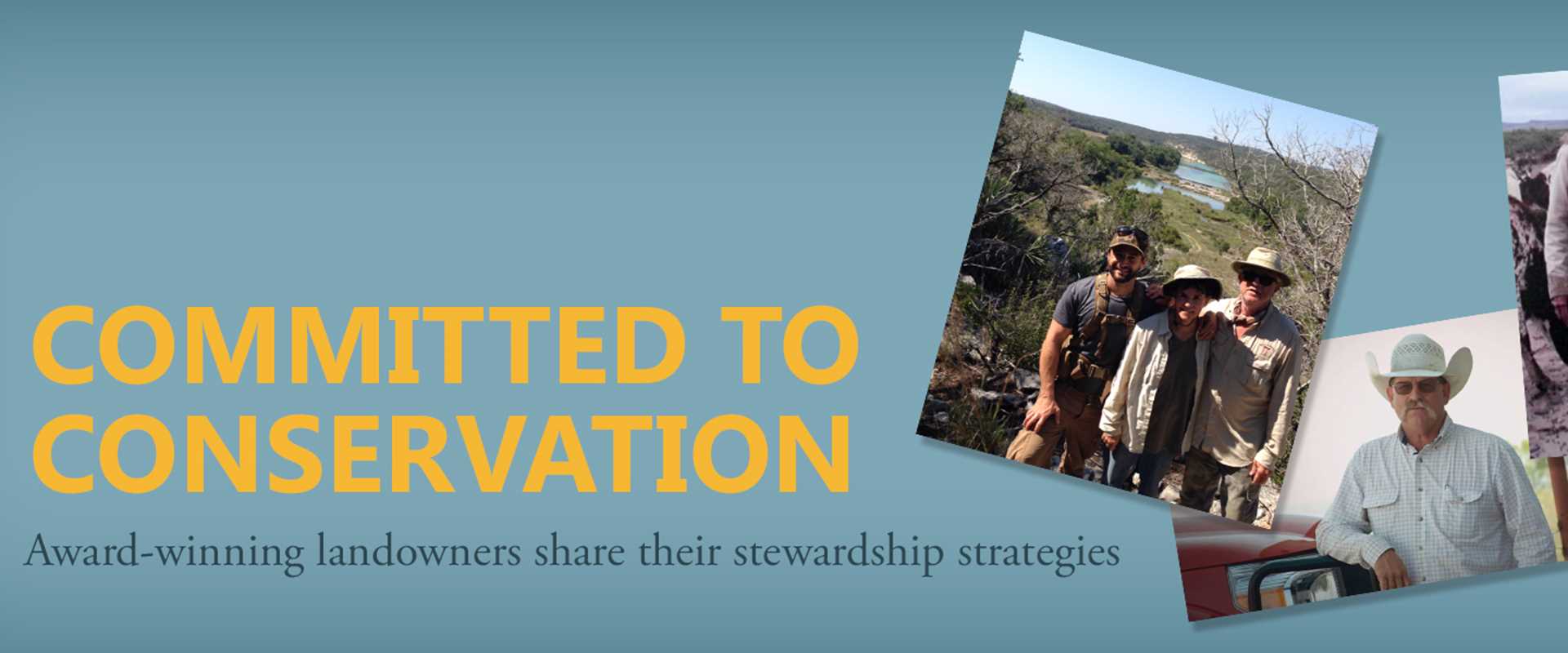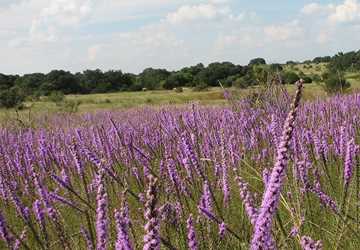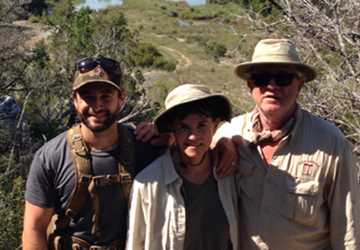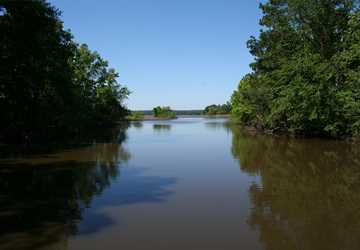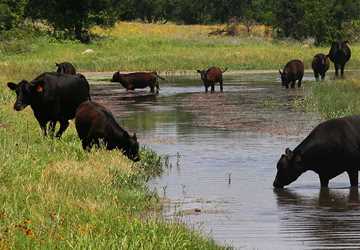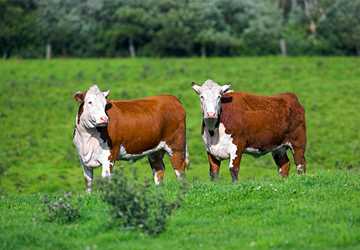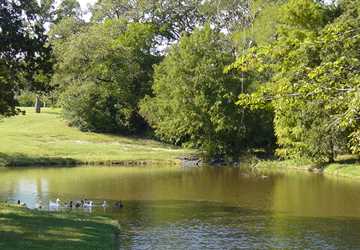By Leslie Lee
In a state where rainfall is often unpredictable and generating income from wildlife or agriculture can be risky business, the challenge of conserving rural land and water resources is a passion project for many Texas landowners.
“If I was a billionaire, I would buy as many ranches as I could and preserve them all,” said Ruthie Russell, owner of Sycamore Canyon Ranch in Val Verde County. “But all I can do is keep doing my best to preserve the land I do have.
“Especially for legacy landowners, land stewardship starts with the deep passion that you have for the land; you’re so bonded to it,” Russell said.
Russell is a third-generation cattle woman and one of the landowners recently recognized by the Texas Parks and Wildlife Department (TPWD) with a 2014 Lone Star Land Steward Award.
Because land conservation is essential to protecting the state’s natural resources, TPWD annually honors land managers and owners in various ecological regions for their accomplishments in land, water and wildlife stewardship, according to TPWD.
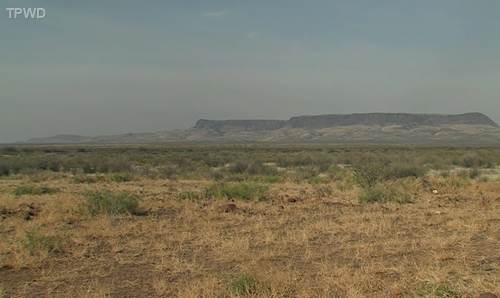
“You can always make something better than you received it,” said Betty Tanksley, owner of Tanksley Land Company in Brewster County and another award recipient. “As a landowner and rancher, you have to be patient in a lot of respects, and you have to be an optimist and look long-term into the future.”
“We demonstrate at Bear Creek Ranch how to use livestock as a tool to improve the land and watershed health,” said Robert Potts, president of the Dixon Water Foundation. Located in Parker County near Fort Worth, the ranch is owned by the foundation, which, along with ranch staff, was also recognized with one of the awards.
After years of consistent and innovative conservation, these landowners and managers were each recognized with one of the regional land steward awards. (Three other groups also received awards; see sidebar for the full list of winners.) Each has employed conservation strategies that can help landowners throughout Texas preserve land and water resources.
Strategic grazing benefits more than pastures
The grazing system used on Bear Creek Ranch may seem complicated, but it actually harkens back to simpler times, Potts said. Today the 2,000-acre ranch accommodates 180 head of cattle by using a grazing program that imitates the grazing of native herbivores, he said.
“We use high-intensity, low-duration grazing, where we’re moving the cattle every couple of days, mimicking the grazing patterns that you would have had on this landscape when bison were there,” Potts said.
The land sits on the shallow soils of the Fort Worth Prairie and has never been plowed, he said. Its native grasses were historically grazed by wild bison and pronghorn.
“The herds would stay in one place for a short time, beat up that land, leave their manure on the ground, fertilize the soil and then move somewhere else and not be back for a while,” he said.
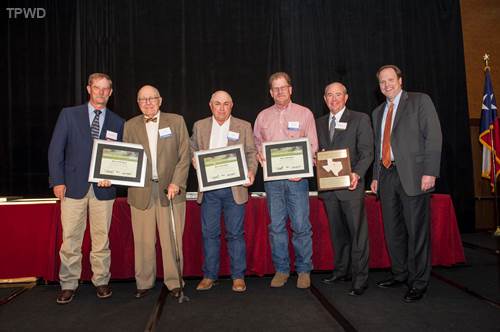
The ranch is divided into 32 grazing units, and each is grazed for five to 15 total days each year.
“We keep all our cattle together, in a relatively small part of the ranch, and we move them often,” Potts said. "That’s the way grasses in this area evolved, and that’s the way we’ve found they do best.”
The many conservation benefits of this grazing strategy helped Bear Creek Ranch win the Lone Star Land Steward Award for the Cross Timbers and Prairies region this year. Clint Josey, foundation board chairman, and ranch managers Robbie Tuggle and Danny Parker were also recognized by TPWD with the award.
Resting parts of the ranch for long periods helps the grasses build a healthy root system that creates organic matter and nurtures the soil, Potts said, and giving pastures a break also improves water infiltration and decreases runoff and erosion.
Healthier pastures and riparian areas have resulted from the foundation’s efforts on the ranch, as well as improved wildlife habitat and populations.
Though the grazing system does require some upfront financial investment for infrastructure, such as fencing and additional water sources for livestock, there is minimal labor involved once the routine is established, and cattle easily adapt to it, Potts said.
“It’s not really labor-intensive at all, because the cattle are used to it; all we have to do is open a gate and blow a whistle, and the cattle go through it, because they know there’s fresh grass on the other side,” he said. “You do have to be out there every day or two, but in terms of moving the cattle, it’s very easy.
“In fact, probably in the long term it reduces labor, because our cattle are so used to being around people and being moved, they are very tame and easy to handle when you have to herd them to do vaccinations and those kinds of things.”
Educating landowners and the public about economically and environmentally sustainable management practices is a mission of the Dixon Water Foundation, which owns three ranches in North Texas and one in West Texas, each used for research and educational demonstrations. Founded in 1994 by the late Roger Dixon, the foundation began managing Bear Creek Ranch, a Dixon family ranch, in 2005.
We keep all our cattle together, in a relatively small part of the ranch, and we move them often. That’s the way grasses in this area evolved, and that’s the way we’ve found they do best.
Foundation staff members encourage landowners to recognize the benefits of strategic grazing, including the creation of pastures that are more drought-resistant and recover more quickly from drought, Potts said.
“As we’re in this drought, and who knows how persistent it will be, it’s very important to make the most of every drop of rain,” he said. “By keeping the ground covered and giving the grass a chance to recover and build up healthy soil that absorbs water, you make much better use of what water you do get and much better range conditions for your cattle, even in dry times.
“That’s what encourages people to do this — the fact that it makes much better use of the rainfall than a continuous grazing system. The question for ranchers is, are you coming into rains with your pastures in good enough shape to respond to it, to hold the water and grow the grass? Or is it so beaten down that the water all runs off?”
A legacy of conservation
Deep in Southwest Texas lies another award-winning property and management team — Tanksley Land Company. Recognized with the 2014 Regional Lone Star Land Steward Award for the Trans Pecos region, the 25,000-acre Tanksley ranch has been in the family since the 1920s. When Betty Tanksley and her late husband, Ben, began managing it in 1989, much of the land was covered by creosote and tarbush. They began using innovative conservation practices to restore the ranch’s grasslands and water resources.
“It’s typical West Texas high desert,” Tanksley said. “Some of it is flat, but it’s a varied landscape, and some of it is more receptive to growing grass than other parts. Since we started working it, we have tried to increase the number of native forbs and grasses through land and grazing management.”
Tanksley credits her husband for successfully increasing water retention and conservation all across their ranch.
“We built and rebuilt a lot of dams, some spreader dams and some larger dams to hold the water,” she said. “Ben also made a lot of divots to hold water and stop so much runoff. I think we certainly improved the grazing capability of the ranch.”
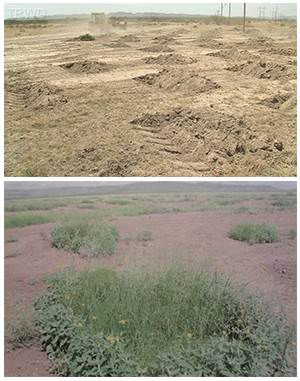
To make divots, he used a bulldozer to dig out an area of soil and create an indention, then threw out a native grass seed mix at each divot to increase forage growth. When rains came, the divot would capture and hold water, eventually turning into a small oasis of grass and forbs that provides grazing for livestock and habitat for wildlife.
They also employed spreader dams to capture runoff and carefully planned each water conservation improvement. “Ben studied the land and the way the water flowed,” she said.
“Before you can start building these things, you have to really know the lay of the land and the water so that you can put them in the right places and get the most bang for your buck.”
Successfully using conservation techniques to improve your land also requires patience and investment, she said.
“Your resources are limited, so you can’t afford to do as much as you’d like in a year; you have to say, ‘Okay this year we’re going to build this dam, or this year we’re going to make these divots,’” Tanksley said. “And then of course some years you have good rainfall, and that helps your grass production, and some years you don’t. Maybe the next year you’ll have pretty good rainfall, and the grasses will appear where they weren’t before.
“Some years you’ll kind of despair, but then all of a sudden the grasses will respond to rain.” Currently, a portion of the ranch is leased to a cattle operation, sustaining about 220 head, Tanksley said.
“In good years, the ranch could carry more than that, but we’re being conservative, because we’ve been pretty dry the last few years, and we’re trying to keep the grass we’ve grown,” she said.
Tanksley advised other landowners to take on conservation improvements as they’re able to, because you can’t do everything all at once.”
Before you can start building these things, you have to really know the lay of the land and the water so that you can put them in the right places and get the most bang for your buck.
“Don’t over-graze,” she said. “Try and improve the water retention; maybe build some dams or spreader dams so that you can keep the water that you’re getting.”
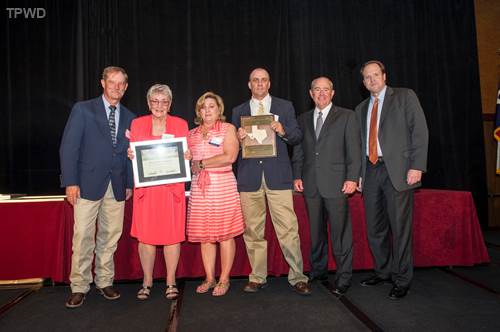
She also emphasized the importance of effective wildlife management and income from wildlife hunting leases, as well as the importance of creating a heritage of conservation.
“I hope that our children and grandchildren will continue the heritage that Ben began with the improvements that we’ve tried to make,” Tanksley said. “I attribute most of the improvements that have been made to my husband’s foresight. I think they see that as a heritage that they need to continue, and that’s my hope — that they continue with the conservation practices that we began.”
Letting wild spaces stay wild
Two counties east of the Tanksley’s land is the uniquely situated Sycamore Canyon Ranch. Bordered by the Devils River and holding land transitioning over three ecoregions — Edwards Plateau, Trans Pecos and Chihuahua Desert — the 8,700-acre South Texas ranch has been owned by Russell and her family since 1974.
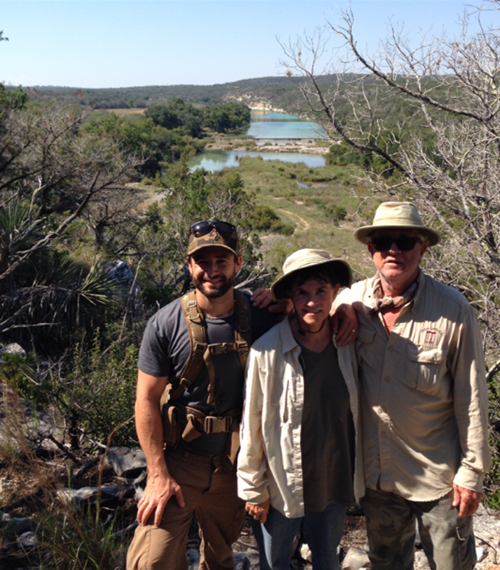
“It’s a beautiful place,” Russell said. “We thought that it was key to protect and conserve this land because not only is it a transitional zone for different ecoregions, it also has multiple springs and 3 miles of riparian land along the Devils River.”
The river is considered by many as one of the most pristine and remote rivers in Texas, and interest in it has increased in recent years, she said.
“The Devils is a beautiful turquoise color, because the riverbed is limestone rock; it’s just gorgeous,” Russell said. “So many more people canoe and kayak it these days, and that footprint can cause us problems every now and then, if trash is left or if there’s fire damage, but one positive thing about it is that more people care about the river now and want to protect it.”
To protect and conserve their land, the first and primary strategy the Russells employed was deferred grazing.
“When we got the ranch, it was very over-grazed from a hundred years of sheep and goats,” she said. “So our main strategy was just letting the grass come back, deferring grazing, so that it could filter the water and slow it down and stop erosion. The better grass cover you have, the more water soaks in and the less sediment you get running down into your rivers.
“We’ve had no livestock on the land and have had it under a wildlife tax exemption for about eight years now. Unlike potentially high-production ranches desiring intense livestock grazing, the steep, stark and rocky slopes of the Devils cry out to be left wild and untouched. Our strategy also has been to control invasive plants like the monocultures of prickly pear moving in as well as huge herds of aoudad (wild Barbary sheep).”
Not having livestock on the land has been essential during drought years, she said.
“A drought limits your options,” Russell said. “With conservation, you need to know when to act and when to step back. A landowner always wants to do something, but sometimes the land can heal itself best.
“For instance, if we would have done any bulldozer work during this drought, nothing would have grown back, and the soil would have washed away.”
Other strategies the family uses include leasing the land for hunting, which helps manage wildlife populations. Russell said that the hunter currently leasing the land has also put out numerous wildlife watering tanks, taking some grazing pressure off of the riparian areas along the river. To coordinate conservation efforts on the ranch, they also follow a management plan developed under TPWD’s advisement, she said.
With conservation, you need to know when to act and when to step back. A landowner always wants to do something, but sometimes the land can heal itself best.
Another tactic the Russell family has used to preserve their ranch is a conservation easement. Working with the Texas Agricultural Land Trust, the Russell family decided to place their land under an easement and protect it forever from development and fragmentation. A conservation easement is a perpetual legal agreement that allows landowners to retain full title and management of their property, while forfeiting (as in the Russell’s case), donating or selling certain development rights to protect the land from commercial or residential development.
“The first thing I wanted to do was get my whole family on board with me on the easement,” she said. “I wanted my two sons to really believe in it, and we involved them throughout the whole process.”
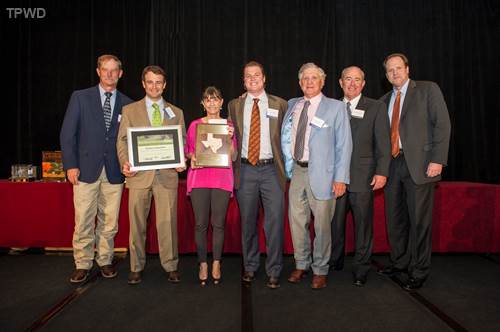
Russell said that she advises other landowners considering easements to make sure their family, children and heirs are in agreement and participate in negotiating an easement.
“Our whole family has been lucky enough to have grown up on ranches and to have inherited ranches from my grandfather, so my kids are just as passionate as I am about keeping wide-open spaces open and fighting land fragmentation,” Russell said.
Although many people might think the Russell’s far end of Texas would be immune to fragmentation, that’s not the case, she said, and she worries that continued development will stress local water and natural resources.
“The Devils River seems so remote, but along our county roads, in what you think is the middle of nowhere, there are actually subdivisions,” she said. “This is barren, stark land; it can’t support many people or water wells.
What open space does for the soul is just immeasurable.
“I’m hoping that other landowners will consider conservation easements and protect the land, water, air, wildlife and habitats here.”
Conserving and protecting private lands provides many benefits to the public, Russell said, including natural beauty and open space.
“Some of the other huge benefits are clean air, clean water and wildlife habitat,” she said. “Here on the Devils, if you’re canoeing the river and you look up, you don’t see a bunch of houses — you see wildlife and wide-open land.
“What open space does for the soul is just immeasurable.”

